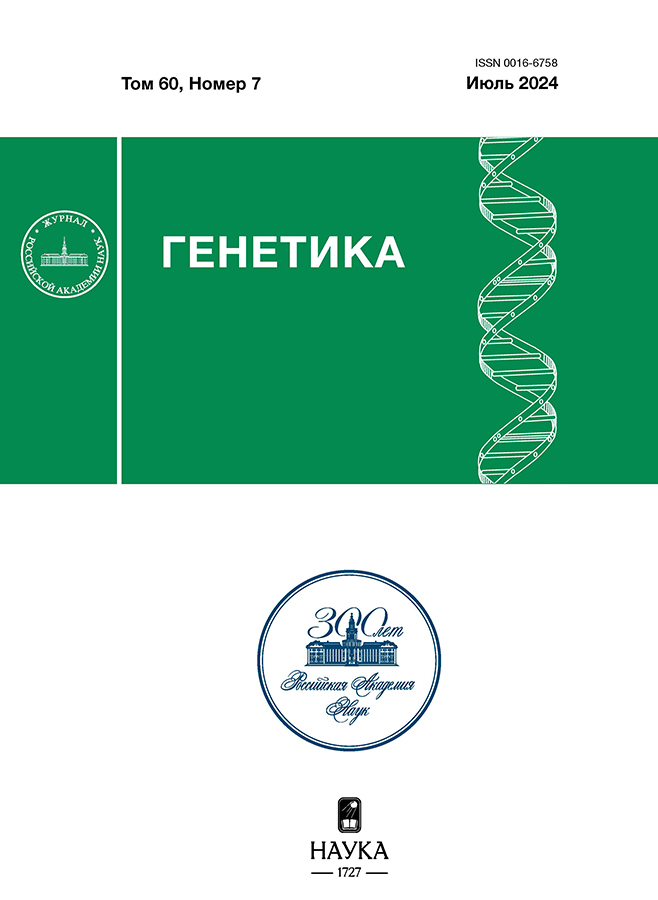Methylation levels in the 5' region of the TBX20 gene in the ascending aorta change in opposite direction in atherosclerosis and aneurysm
- Autores: Koroleva Y.А.1, Goncharova I.A.1, Zarubin A.А.1, Shipulina S.А.1, Sleptsov A.A.1, Panfilov D.S.1, Kozlov В.N.1, Nazarenko M.S.1
-
Afiliações:
- Tomsk National Research Medical Center, Russian Academy of Sciences
- Edição: Volume 60, Nº 7 (2024)
- Páginas: 100-106
- Seção: КРАТКИЕ СООБЩЕНИЯ
- URL: https://transsyst.ru/0016-6758/article/view/667237
- DOI: https://doi.org/10.31857/S0016675824070091
- EDN: https://elibrary.ru/BHIOTN
- ID: 667237
Citar
Texto integral
Resumo
We found hypomethylation of 5 CpG sites in the 5’region of TBX20 gene (7p14.2) in the tissues of atherosclerotic aortic plaque compared to dilated part of aorta in patients with ascending aortic aneurysm. Using GEO database, we found that the DNA methylation level in the chr7:35253926-35262250 region changes in opposite direction in aortic dissection and aortic atherosclerosis. The results suggest an alteration in epigenetic regulation both in aortic atherosclerosis andaortic aneurysm.
Palavras-chave
Texto integral
Sobre autores
Yu. Koroleva
Tomsk National Research Medical Center, Russian Academy of Sciences
Autor responsável pela correspondência
Email: yuliya.koroleva@medgenetics.ru
Research Institute of Medical Genetics
Rússia, 634050, TomskI. Goncharova
Tomsk National Research Medical Center, Russian Academy of Sciences
Email: yuliya.koroleva@medgenetics.ru
Research Institute of Medical Genetics
Rússia, 634050, TomskA. Zarubin
Tomsk National Research Medical Center, Russian Academy of Sciences
Email: yuliya.koroleva@medgenetics.ru
Research Institute of Medical Genetics
Rússia, 634050, TomskS. Shipulina
Tomsk National Research Medical Center, Russian Academy of Sciences
Email: yuliya.koroleva@medgenetics.ru
Research Institute of Medical Genetics
Rússia, 634050, TomskA. Sleptsov
Tomsk National Research Medical Center, Russian Academy of Sciences
Email: yuliya.koroleva@medgenetics.ru
Research Institute of Medical Genetics
Rússia, 634050, TomskD. Panfilov
Tomsk National Research Medical Center, Russian Academy of Sciences
Email: yuliya.koroleva@medgenetics.ru
Research Institute of Cardiology
Rússia, 634012, TomskВ. Kozlov
Tomsk National Research Medical Center, Russian Academy of Sciences
Email: yuliya.koroleva@medgenetics.ru
Research Institute of Cardiology
Rússia, 634012, TomskM. Nazarenko
Tomsk National Research Medical Center, Russian Academy of Sciences
Email: yuliya.koroleva@medgenetics.ru
Research Institute of Medical Genetics
Rússia, 634050, TomskBibliografia
- Portelli S.S., Robertson E.N., Malecki C. et al. Epigenetic influences on genetically triggered thoracic aortic aneurysm // Biophys. Rev. 2018. V. 10. № 5. P. 1241–1256. https://doi.org/10.1007/s12551-018-0460-1
- Liu P., Zhang J., Du D. et al. Altered DNA methylation pattern reveals epigenetic regulation of Hox genes in thoracic aortic dissection and serves as a biomarker in disease diagnosis // Clin. Epigenetics. 2021. V. 13. № 1. P. 124. https://doi.org/10.1186/s13148-021-01110-9
- Leone O., Corsini A., Pacini D. et al. The complex interplay among atherosclerosis, inflammation, and degeneration in ascending thoracic aortic aneurysms // J. Thorac. Cardiovasc. Surg. 2020. V. 160. № 62. P. 1434–1443. https://doi.org/10.1016/j.jtcvs.2019.08.108
- Isselbacher E.M., Preventza O., H. Black J. 3rd. et al. ACC/AHA guideline for the diagnosis and management of aortic disease: A report of the American Heart Association // Circulation. 2022. V. 146. № 24. P. e334– e482. https://doi.org/10.1161/CIR.0000000000001106
- Chau K.H., Bender J.R., Elefteriades J.A. Silver lining in the dark cloud of aneurysm disease // Cardiology. 2014. V. 128. № 4. P. 327–332. https://doi.org/10.1159/000358123
- Weininger G., Ostberg N., Shang M. et al. Lipid profiles help to explain protection from systemic atherosclerosis in patients with ascending aortic aneurysm // J. Thorac. Cardiovasc. Surg. 2022. V. 163. № 2. P. e129–e132. https://doi.org/10.1016/j.jtcvs.2021.09.031
- Nassar L.R., Barber G.P., Benet-Pagès A. et al. The UCSC Genome Browser database: 2023 update // Nucl. Ac. Res. 2023. V. 51. № D1. P. D1188–D1195. https://doi.org/10.1093/nar/gkac1072
- Barrett T., Wilhite S.E., Ledoux P. et al. NCBI GEO: archive for functional genomics data sets--update // Nucl. Ac. Res. 2013. V. 41. P. D991–D995. https://doi.org/10.1093/nar/gkac1072
- Chen Y., Xiao D., Zhang L. et al. The role of Tbx20 in cardiovascular development and function // Front. Cell Dev. Biol. 2021. V. 9. https://doi.org/10.3389/fcell.2021.638542
- Kirk E.P., Sunde M., Costa M.W. et al. Mutations in cardiac T-box factor gene TBX20 are associated with diverse cardiac pathologies, including defects of septation and valvulogenesis and cardiomyopathy // Am. J. Hum. Genet. 2007. V. 81. № 2. P. 280–291. https://doi.org/10.1086/519530
- Luyckx I., Kumar A.A., Reyniers E. et al. Copy number variation analysis in bicuspid aortic valve-related aortopathy identifies TBX20 as a contributing gene // Eur. J. Hum. Genet. 2019. V. 27. № 7. P. 1033–1043. https://doi.org/10.1038/s41431-019-0364-y
- Tcheandjieu C., Xiao K., Tejeda H. et al. High heritability of ascending aortic diameter and trans-ancestry prediction of thoracic aortic disease // Nat. Genet. 2022. V. 54. № 6. P. 772–782. https://doi.org/10.1038/s41588-022-01070-7
- Sollis E., Mosaku A., Abid A. et al. The NHGRI-EBI GWAS Catalog: Knowledgebase and deposition resource // Nucl. Ac. Res. 2023. V. 51. № D1. P. D977–D985. https://doi.org/10.1093/nar/gkac1010
- Li Y., Ren P., Dawson A. et al. Single-cell transcriptome analysis reveals dynamic cell populations and differential gene expression patterns in control and aneurysma l human aortic tissue // Circulation. 2020. V. 142. № 14. P. 1374–1388. https://doi.org/10.1161/CIRCULATIONAHA.120.046528
- Ma W.F., Hodonsky C.J., Turner A.W. et al. Enhanced single-cell RNA-seq work-flow reveals coronary artery disease cellular cross-talk and candidate drug targets // Atherosclerosis. 2022. V. 340. P. 12–22. https://doi.org/10.1016/j.atherosclerosis.2021.11.025
- Hodonsky C.J., Turner A.W., Khan M.D. et al. Integrative multi-ancestry genetic analysis of gene regulation in coronary arteries prioritizes disease risk loci // medRxiv. 2023. V. 2. https://doi.org/10.1101/2023.02.09.23285622
- Lacey M., Baribault C., Ehrlich K.C., Ehrlich M. Atherosclerosis-associated differentially methylated regions can reflect the disease phenotype and are often at enhancers // Atherosclerosis. 2019. V. 280. P. 183–191. https://doi.org/10.1016/j.atherosclerosis.2018.11.031
- Yang X., Kong Q., Li Z. et al. Association between the promoter methylation of the TBX20 gene and tetralogy of fallot // Scand. Cardiovascular J. 2018 V. 52. № 5. P. 287–291. https://doi.org/10.1080/14017431.2018.1499955
- Gong J., Sheng W., Ma D. et al. DNA methylation status of TBX20 in patients with tetralogy of Fallot // BMC Med. Genomics. 2019. V. 12. № 1. P. 75. https://doi.org/10.1186/s12920-019-0534-3
Arquivos suplementares











